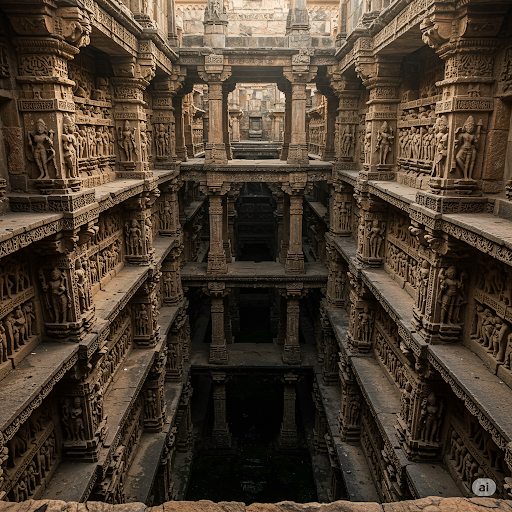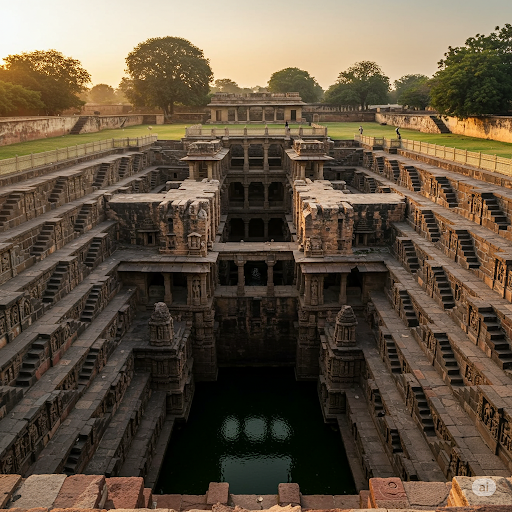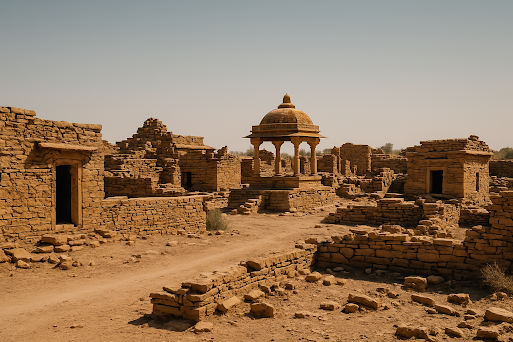🛕 Rani Ki Vav – The Queen’s Stepwell: Gujarat’s Underground Masterpiece
“A tribute of love, devotion, and divine design – where every step is a descent into 11th-century brilliance.”
📍 Location: Patan, Gujarat, on the banks of the Saraswati River
🏛️ Name: Rani Ki Vav (The Queen’s Stepwell)
✨ Significance: A stunning example of ancient Indian engineering, symbolism, and sculptural mastery
🌊 Purpose: More than just a stepwell – it served as water storage, a spiritual shrine, and a social space
🏆 Status: Recognized as a UNESCO World Heritage Site
🎨 Essence: A visual poem carved in stone, blending devotion, art, and architecture seamlessly
👑 A Queen’s Tribute of Love:
Commissioned in 1063 CE by Queen Udayamati, wife of King Bhima I of the Chaulukya Dynasty, this architectural wonder served both:
-
A practical purpose: Providing water in arid Gujarat.
-
A spiritual one: Honoring the sanctity of water through an inverted temple layout.
Buried under layers of silt for centuries and rediscovered in 1958, Rani Ki Vav was lovingly restored by the Archaeological Survey of India during the 1980s.
📝 Fun Historical Note: It was praised in the 14th-century text Prabandha-Chintamani by Jain scholar Merutunga as “more magnificent than the Sahasralinga Tank.”
🏛️ Architectural Brilliance: Where Form Meets Function
📐 Structural Highlights:
-
Depth: 28 meters (like a 9-story building!)
-
Length & Width: 64m × 20m
-
Orientation: East-west alignment for optimal sunlight
-
Shadow Mystery: The western pavilion’s pillars cast no shadow at noon, showcasing precise architectural alignment (Vastu Shastra at work!)
💧 The structure features seven levels of pavilions, each carved with over 800 elaborate sculptures, and is designed for natural air circulation, water filtration, and temperature regulation.
🎭 A Gallery of Stone – Sculptural Grandeur:
Every pillar, wall, and platform is a canvas of intricate carvings that celebrate:
✨ Divine Imagery
-
The Dashavatara (10 avatars of Vishnu), including a 25-ft reclining Vishnu
-
Shiva, Ganesha, Durga, Brahma, and more
-
The Navagrahas (Nine Planets) and Ardhanarishvara
👩🦰 Feminine Beauty & Daily Life
-
Apsaras (celestial maidens) in 16 moods — from dancing to applying lipstick
-
Women writing letters, feeding children, grooming — reflecting medieval societal roles
🐘 Mythical Beasts & Symbolism
-
Kalpavriksha (wish-fulfilling tree), elephants, makaras, lions
-
Delicate patterns inspired by Patola textiles and floral motifs
🔍 3 Hidden Gems You Might Miss:
-
Shadowless Pillars – Optical illusion that stuns even modern architects.
-
Secret Tunnel – A mythical underground passage said to connect Patan to Siddhpur (125km away).
-
Erotic Panels – Discreetly placed fertility carvings, typical of ancient Indian temple art.
🛠️ Conservation & Recognition:
-
1958: Rediscovered after being buried for centuries.
-
1980s: Restored by the ASI, uncovering over 50 lost sculptures.
-
2014: Recognized as a UNESCO World Heritage Site.
-
2016: Declared India’s Cleanest Heritage Site.
-
2018: Featured on the ₹100 Indian currency note, making it a national icon.
💬 Why Rani Ki Vav Leaves a Lasting Impact:
“This isn’t just architecture – it’s frozen poetry. The feminine grace captured in stone by 11th-century artisans surpasses what modern hands can create.”
– Dr. Kirit Mankodi, Archaeologist
Whether you're a history enthusiast, art lover, spiritual seeker, or just a curious traveler, Rani Ki Vav will captivate your soul and imagination.





Comments
Post a Comment